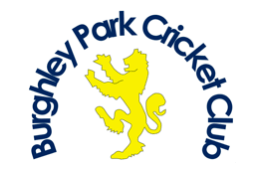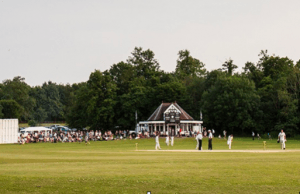Burghley Park
Founded: 1771
Leagues played in: Hunts Cricket League, South Lincs and Border League
Contact details: Derek Patience, dcpatience@hotmail.co.uk
Website: http://bp.play-cricket.com
The early history of the club is inextricably linked to the Cecil family of Burghley House, under whose patronage the club has been from the very outset.
The first mention of a cricket club in Stamford is to be found in the Stamford Mercury of 20th June 1771, when an announcement was made that the club would hold meetings every Tuesday fortnight at the Racecourse Ground, which was situated a couple of miles south of Stamford just off the Great North Road. The racecourse had been in existence since 1717, and because of its location adjacent to Burghley Park, was similarly well patronised by the Cecils.
At that time the club was known as the Stamford Cricket Club, and early scoresheets detailed in the Mercury indicate that its membership was drawn primarily from the local gentry, including a number of the Cecil family itself.
During the early part of the 19th century, activity seems to have dried up, possibly as the result of the Napoleonic Wars, which drew younger menfolk away from such pursuits, but a year or two after the Waterloo conflict in 1815, the club seems to have revived.
The club continued to play at the Racecourse ground until 1854, when it moved to its present ground within Burghley Park, following which it gradually became known as Burghley Park Cricket Club. The following year, the club hosted a match between 22 of Stamford v the All England XI, and gave a good account of themselves, with the three day match ending as a draw. The match was played at the Racecourse Ground rather than at the new ground in Burghley Park.
The strength of the club grew through the next couple of decades, as did the quality of its fixture list, with regular matches against MCC, Free Foresters and I Zingari. By the 1870s it became by far the strongest club in the area, and in 1877 achieved the rare double of beating MCC both at home and at Lords.
The previous year, the club played a match against an XI raised by the Earl of Westmorland, whose stately home at Apethorpe lies a few miles from Stamford. His side included none other than W.G.Grace, along with James Southerton, a professional bowler who played in the very first Test match between England and Australia later the next year. The match was drawn, but Grace was dismissed for just 15 in his first innings, and was 22 not out in his second when stumps were drawn. He and Southerton between them accounted for 16 of the 19 Burghley wickets to fall.
The following year the Earl fielded an even stronger XI including, alongside Southerton and W.G.Grace, his brother G.F.Grace and W.R.Gilbert, another who featured in the very first Test later that year. The Earl’s XI posted 205 in their first innings, with W.G. scoring 110 and Gilbert 51, and dismissed Burghley for 43 and 84 to win by an innings and 78 runs. This time Southerton, with 11, and Grace, 9, took all 20 wickets to fall.
The club continued to thrive throughout the remainder of the century, and in 1892 a new pavilion was erected, at a cost of £287, following fund-raising events and donations from various individuals. Later that year a scorebox was added at a cost of £18. In the same year, the club engaged its first professional, who was paid 50 shillings per week, with an end-of-season benefit of £20.
Professionals were engaged annually thereafter right up until the commencement of the Great War in 1914. Throughout this period, the fixture list remained strong, and the club prospered. The club endeavoured to continue playing through the 1915 season, arranging matches against various military regiments stationed in the area, but by the following year, it proved difficult to get fixtures, although arrangements were put in hand to keep the ground in order. Cricket resumed in 1918, when the ground was let to the Military Sports Club.
In common with other clubs at this time, the club found it difficult to recruit new players, but three XIs were fielded in 1919, although the minutes expressed concerns regarding the weakness of these teams. Recovery was, however, quite rapid over the next two seasons, such that by 1922, the Hon. Secretary was able to report on a “splendid season” and remarked on “the better tone of the club”. By 1928 progress was such that it was possible to purchase a new motor mower for the then enormous sum of £100 (paid for over 3 years with an initial deposit of £50, and two further instalments of £25). In today’s terms this cost would be equivalent to some £5,600. At the same time a part-time groundsman was employed.
By the mid 30s the player base was clearly ageing, and efforts were being made to attract younger members, and at the same time problems arose with the ground – in 1936 the grass on the square was killed off by excessive use of fertiliser, and by the end of 1938 a “thorough renovation” was required at a cost of more than £38. No doubt the condition of the square did little to attract new, younger members.
The outbreak of war in 1939 brought about the closure of the club, and little cricket was played on the ground until the commencement of the 1946 season, when the minutes record that, due to the late decision to re-form the club, only a limited number of matches were played, and much time and expense devoted to bringing the ground and pavilion back to standard. From 1947 onwards, things got back to normal, although, again, the difficulties of attracting younger members was noted.
In the 1950s the club’s cricket week, which had originally been started prior to the Great War, was revived, and in 1959 an evening 6-a-side knockout competition was introduced into it. Both events continue to this day. The club thrived throughout the 60s and 70s thanks to the efforts of stalwart members such as Peter Johnson, David Cross, Bob Duckett and many others.
In 1969, the club became one of the founding members of the South Lincs Cricket League, and over the course of the next few decades won the competition on a number of occasions. When the Lincolnshire Premier League was formed in 1999, Burghley Park was invited to join, but, following an extraordinary meeting of members, declined on account of the extra travelling that would be involved and continued its membership of the South Lincs League.
In 2004 the club opted to join the Cambridgeshire Tucker League, but this move coincided with a decline in membership of the club, and it was relegated into the Hunts Cricket League Div. 1. Further relegation into Division 2 followed a couple of years later, by which time the club’s nadir had been reached, and it very nearly wound up. An influx of new members brought about by the current Club Captain, Chris Meadows, saw a revival in its fortunes, and promotion back to Division 1 was won in 2009. Since then progress has been steadily upward, and a 2nd XI was entered into the league again in 2015.
The most important event in the club’s season remains its Cricket Week, and in particular the Sixes competition, which now attracts more than a thousand spectators to the Finals night.



